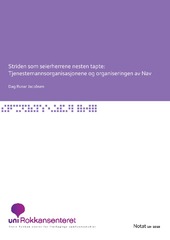| dc.contributor.author | Jacobsen, Dag Runar | eng |
| dc.date.accessioned | 2012-01-05T14:40:51Z | |
| dc.date.accessioned | 2020-12-10T06:34:31Z | |
| dc.date.available | 2012-01-05T14:40:51Z | |
| dc.date.available | 2020-12-10T06:34:31Z | |
| dc.date.issued | 2010-08 | eng |
| dc.identifier.issn | 1503-0946 | |
| dc.identifier.uri | https://hdl.handle.net/1956/5361 | |
| dc.description.abstract | This paper focuses on state employees’ unions and their role in the merger process of the Norwegian employment service, the social insurance service, and parts of the local social assistance service at the local level. This event is referred to as the Nav reform, and special attention is devoted to how Nav was organized. Three main questions are pursued: what happened, why it happened, and what part did the state employees’ unions play in the process. Where they opponents or supportive? It is vital to discuss the importance of the unions’ participation in the implementation of the reform, especially how it effected the decisions concerning the main dimensions of organising, how they were interpreted, defined and carried out through out the reform. The study shows that the Nav reform process didn’t become an unambiguous process resulting in a robust outcome. The organizing of Nav started with plans and models where the local and multifunctional Nav-offices were at the centre of the reform as the core criteria of success. The main reform symbol was clients facing only «one door». The model that became central in the implementation the first years however, implied a superior focus on the regional administration in the Nav service. That implied an extensive transfer of tasks, employees’ and competence from the local Nav-offices to this «behind the scene» administration. The division of labour, coordination and what was talked-about and discussed as the interface between these units in Nav immediately became an area of problems and conflicts. The importance of the «one door» idea, the multifunctional and authoritative local Nav-office did however get approval and support throughout 2009 and 2010. Not the least because of the constant ongoing political processes and battles of definitions on how to organise Nav and the state employees’ unions’ part in that process. The political and ambiguous character of the process had much to do with the fact that there were three parallel arenas for decisions and interpretation in the reform. The political arena, the Nav administrative and the internal negotiation based arena in Nav. In this process the state employees’ unions became very important along two dimensions. First of all in formulating, expressing and sustaining a theory of opposition in relationship to the reform. Especially in formulating a critique against the reduced importance of the local offices and the strengthened role of the regional administration in the reform theory and the interpretations of political decisions held by the administrative management and managing director of Nav. Secondly that the state employees’ unions delivered vital contributions based on competence and identities prior to the merger. Because of the reform process they were the only organizations that still formally identified with cultural elements from the old services. In doing so these organizations were decisive in elaborating and maintaining alternative reform and organizational models. | en_US |
| dc.description.abstract | Dette notatet retter oppmerksomheten mot tjenestemannsorganisasjonenes rolle i Nav-reformen, og fokuserer særlig på viktige sider ved prosessen knyttet til organiseringen av Nav-etaten. Det er tre spørsmål som står sentralt: hva som skjedde, hvorfor det skjedde, og hvilken rolle tjenestemannsorganisasjonene spilte i prosessen. Var de medspillere eller motspillere. Det legges særlig vekt på hvilken betydning tjenestemannsorganisasjonenes rolle og deltagelse hadde for gjennomføringen av reformen, i form av hvordan hoveddimensjonene for organiseringen av Nav ble besluttet, fortolket, definert og iverksatt ut over i reformprosessen. Analysen viser at organiseringen av Nav ikke ble en entydig prosess i retning av et robust utfall. Organiseringen av Nav startet med planer og modeller hvor de lokale og multifunksjonelle Nav-kontorene var i reformens midte som det avgjørende suksesskriterie. Det bærende reformsymbolet var «en dør» i møte med brukeren. Den modellen som ble sentral i iverksettingen de første årene innebar imidlertid et overordnet fokus på betydningen av «baklandet» i etaten. Det vil si forvaltnings- og spesialenhetene, og omfattende overføring av oppgaver, ansatte og kompetanse fra de lokale Nav-kontorene til dette baklandet. Arbeidsdelingen, koordineringen og det som ble omtalt som grensesnittet mellom disse enhetene i Nav-etaten ble umiddelbart et konfliktområde og problemområde for reformprosessen. Betydningen av den ene «døren» og det multifunksjonelle og myndige lokale Nav-kontor fikk imidlertid sitt gjennomslag utover i 2009 og 2010. Ikke minst på grunn av stadig pågående politiske prosesser og definisjonskamper om Navetatens organisering og reformens retning, og tjenestemannsorganisasjonenes rolle i dette. Prosessens politiske og lite entydige karakter hadde mye å gjøre med at det var tre parallelle arenaer for vedtak og fortolkninger som var sentrale i Nav-reformen. Den politisk, den Navadministrative og den forhandlingsbaserte i Nav-etaten. I denne prosessen ble tjenestemannsorganisasjonene svært sentrale langs to forhold. For det første å utforme og opprettholde en opposisjonsteori for reformen med særlig kritikk mot kontorenes neddempede rolle og forvaltningsenhetenes oppblåste rolle i den sentrale ledelsens reformteori og fortolkning av politiske vedtak. For det andre at tjenestemannsorganisasjonene som formelle organisasjoner har vært avgjørende bidragsytere i å holde det institusjonelt betingede (kultur, verdier, logikk) fundamentet levende som nødvendige premissleverandører og innholdsleverandører til supplerende modeller og fortolkninger av reformens retning og etatens organisering. | en_US |
| dc.language.iso | nob | eng |
| dc.publisher | Stein Rokkan Centre for Social Studies | eng |
| dc.relation.ispartofseries | Working Paper | en |
| dc.relation.ispartofseries | 10-2010 | en |
| dc.title | Striden som seierherrene nesten tapte: Tjenestemannsorganisasjonene og organiseringen av Nav | eng |
| dc.type | Working paper | eng |
| dc.rights.holder | Copyright Stein Rokkan Centre for Social Studies. All rights reserved | |
| dc.subject.nsi | VDP::Samfunnsvitenskap: 200 | nob |
